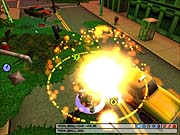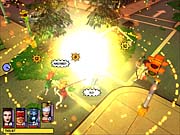Freedom Force Updated Preview
We took a trip to EA to take a look at the latest build of Freedom Force.

Look! In the sky! It's a bird! It's a plane! Is it Superman? Not quite, but Irrational Games--the development team behind System Shock 2--hopes that its latest game, Freedom Force, inspires the same kind of excitement in the minds of comic book fans. Just about everything in Freedom Force, from the origin stories of the characters to the special abilities of the heroes and villains, has a distinct Jack Kirby feel that should appeal to fans of classic comics and those who find humor in over-the-top dialogue and art. Freedom Force's gameplay is particularly noteworthy. Whereas previous comic book games have used the basic action-platforming formula, Freedom Force uses a strategy system in which you select your character's next move depending on the situation. It's a somewhat unique approach that should bring some much-needed depth to the comic-book-inspired genre and restore the integrity of comic book games.

When you begin playing Freedom Force, you'll be treated to an origin story featuring one of the game's lead characters, Minuteman. While sitting in the park one day, an old scientist named Frank Stiles overhears two people speaking, one of whom has a Russian accent. Frank starts to realize that one of the two is a fellow scientist named O'Conner. O'Conner is one of the scientists the working on the Manhattan Project, and he had accused Frank of giving vital secrets to the Russians. The backstabbing scientist ends up shooting Frank in the chest, leaving him to crawl to a nearby statue of a revolutionary war minuteman that appears to be glowing. As the two escape, Frank gains mysterious powers from the statue that transform him into Minuteman.
Your first mission as Minuteman is basically a tutorial, and your main objective to capture O'Conner before he manages to get away. Much like in strategy games and RPGs, you can move characters onscreen by simply clicking on them and then clicking on the appropriate area of the level. Since Minuteman is a superhero, there aren't really any objects that can block his path--not even tall buildings--so you can pretty much maneuver him into any area. The fact that these characters can go anywhere becomes useful in later levels, where you need to take a stealthier approach to taking out enemies as opposed to running at them head on--though, there are plenty of occasions that call for brute force as a primary strategy. In this first mission, you'll also learn how to manipulate the camera, which can be zoomed in to magnify details on character models and environments or zoomed out to survey the area and get an idea of where enemies are located.
When it comes time to actually attack a thug or villain, Freedom Force presents a number of different offensive and defensive options that have various benefits and drawbacks, and deciding how to attack your opponents constitutes a large portion of the game's strategy element.
But Can You Create Batman?

If you want to keep it simple, you can use a hero's default attack by simply clicking the left mouse button. This basic attack works well in the first stage, since most of the enemies you encounter are basically just thugs with pistols, but as you progress further into the game, the enemies become much more difficult to deal with, so you'll need to use each hero's special abilities--like Minuteman's patriot swing--to get the job done.

There are other ways to attack enemies that don't really involve anything other than sheer strength. You can interact with just about any object within Freedom Force's environments--lampposts can be ripped from the ground and cars can be lifted into the air, for example--and these objects can be used as weapons. Not surprisingly, these objects can deal a substantial amount of damage to a group of enemies, and oftentimes, you'll use them if you're being swarmed by enemies. However, since these objects--particularly cars--tend to be imprecise when used as weapons, they can cause collateral damage to the surrounding buildings and civilians.
Whenever you cause a building to collapse or injure an ordinary person who happens to be walking by, you lose prestige points. These are points that you receive for completing objectives within a mission and overall mission performance, which includes the evaluation of any collateral damage. If you fail to complete a secondary objective, or if a building happens to collapse because you inadvertently threw a car into it, then the amount of points awarded diminishes. Whatever points you receive can be distributed to individual character statistics--like special powers, speed, agility, and others--at the end of a mission.
During some of the later missions, it becomes increasingly difficult to avoid collateral damage due to the increased difficulty and the fact that you have more team members to deal with. In one particular mission, you'll have to guide El Diablo, Eve (a superhero who happens to be in touch with nature), and two Freedom Force members of your choice through the city to find a villain responsible for bringing tree monsters into the city. The catch is that you have to keep Eve alive at all costs, because she's the key to solving the puzzle of the plant menace, so collateral damage becomes somewhat of an afterthought if it means life or death for Eve.
Other than the 24-mission single-player campaign, Freedom Force has a number of other features. There's a character creation feature that allows you to build a character from the ground up by giving him or her different abilities and various attributes that can provide a strategic advantage in certain situations. In addition, this feature includes a skin importer so you can create skins--including those that may look incredibly familiar--and use them on your created character. Freedom Force also includes a multiplayer feature that essentially does away with the semi-real-time battle system in exchange for a full real-time system. The multiplayer mode will also include different match types that fit within the theme of the game, such as capture the hostage, a variation on capture the flag. In any case, whether you're a hard-core fan or just a casual comic book reader, there'll be quite a bit to be excited about when Freedom Force is released in March of 2002.
Got a news tip or want to contact us directly? Email news@gamespot.com
Join the conversation